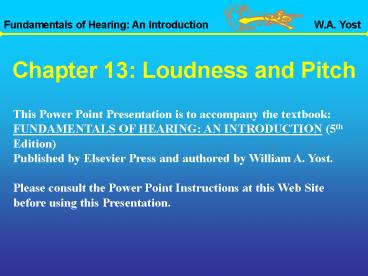Fundamentals of Hearing: An Introduction W.A. Yost Chapter - PowerPoint PPT Presentation
1 / 8
Title:
Fundamentals of Hearing: An Introduction W.A. Yost Chapter
Description:
Fundamentals of Hearing: An Introduction W.A. Yost Chapter 13: Loudness and Pitch This Power Point Presentation is to accompany the textbook: – PowerPoint PPT presentation
Number of Views:41
Avg rating:3.0/5.0
Title: Fundamentals of Hearing: An Introduction W.A. Yost Chapter
1
Chapter 13 Loudness and Pitch
This Power Point Presentation is to accompany the
textbook FUNDAMENTALS OF HEARING AN
INTRODUCTION (5th Edition) Published by Elsevier
Press and authored by William A. Yost. Please
consult the Power Point Instructions at this Web
Site before using this Presentation.
2
Equal Loudness Contours
In this demonstration there are three comparison
tones150 Hz, 1000 Hz, and 7000 Hz. The standard
tone is 1000-Hz. For each of three conditions,
each comparison tone is paired five times with
the standard tone. For each condition, the level
of the comparison tone starts at 5 dB more
intense than the 1000-Hz standard and then
decreases by 5 dB for each of the remaining four
comparisons. For each condition, you are to
decide when the perceived loudness (ignore the
pitch difference) of the two tones (standard and
comparison) is the same. That is, for which
pairing (1-5) do the two tones appear to be
equally loud?
1000-Hz Comparison
7000-Hz Comparison
150-Hz Comparison
150-Hz Comparisons
Standard
3
Missing Fundamental Pitch
A 200-Hz missing-fundamental tonal complex and a
300-Hz missing-fundamental tonal complex are
compared. The 200-Hz complex consists of 600-Hz,
800-Hz, 1000-Hz, 1200-Hz, 1400-Hz, 1600-Hz, and
1800-Hz components (the 3rd-9th harmonics of 200
Hz). The 300-Hz complex consists of 600-Hz,
900-Hz,-1200 Hz, 1500-Hz, and 1800-Hz components
(the 2nd-6th harmonics of 300 Hz). The perceived
complex pitch should increase from the first
(200-Hz missing fundamental complex) to the
second (300-Hz missing fundamental
complex) presentation. There are five
comparisons. The time domain waveform and
amplitude spectrum are displayed.
Time Domain
Frequency Domain
4
Simple and Complex Pitch
All four of these simple and complex sounds have
the same complex pitch of 200 Hz. The sounds are
a 200-Hz sinwave, a click train with a 200-Hz
periodicity, a harmonic series of tones with a
fundamental of 200 Hz and the next six harmonics,
and a harmonic series of tones with a missing
fundamental of 200 Hz and the 3rd through 8th
harmonics. The time domain and amplitude spectrum
for each sound are displayed.
Frequency Domain
Time Domain
5
Pitch Shift of the Residue
A tonal harmonic complex with the 2nd-7th
harmonics of 200-Hz, producing a 200-Hz missing
fundamental pitch, is compared to a sound with
these harmonics all shifted up 75 Hz, producing a
pitch-shift of the residue stimulus. The
comparison is repeated five times. The amplitude
spectrum of each complex sound is also shown.
Pitch-Shift of the Residue
6
Pitch of Iterated Rippled Noise
Two samples of iterated ripple noise (IRN) are
played five times. The two samples differ in
pitch the first sample has a pitch of 200 Hz and
the second sample a pitch of 500 Hz. The time
domain waveform and the amplitude spectrum of
each sample are also shown--red figures for
500-Hz pitch blue figures for 200-Hz pitch IRN
stimulus.
IRN
7
Cubic-Difference Tone
This demonstration is a simulation of the
generation of a cubic-difference tone (CDT) by a
nonlinear system. Three, three-second complex
sounds are presentedthe first has components at
840-Hz and 1000-Hz (the Primaries, which should
generate a 680-Hz CDT), the second has
components at the Primaries and at 683 Hz (the
Beat Tone, which is 3-Hz different than the
680-Hz CDT), and the third has the Primaries
plus the Beat Tone and a 680-Hz tone
(Cancellation Tone, which is presented 180o out
of phase with the 680-Hz CDT). A faint 3-Hz beat
should be perceived for the second sound, but not
for the first and last sound.
CDT
8
Timbre
Two tonal complexes having the same complex pitch
(200 Hz), same duration (500 msec), and same
loudness are compared five times. The perceptual
difference between the two sounds is usually
referred to as a timbre difference. The amplitude
spectrum of each sound is shown.
Timbre































